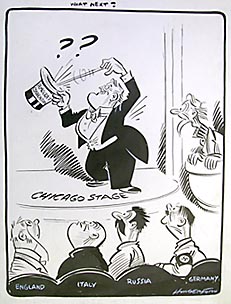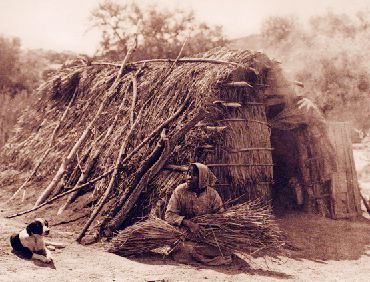

Contents
Nassau notes
Ceremony marks beginning of year
The University will mark the beginning of the academic year with Opening Exercises at 3 p.m. Sunday, Sept. 5, in the University Chapel.
The annual interfaith service will include an address by President Tilghman and the recognition of academic achievements of undergraduate students. It is open to all members of the University community.
Classes begin on Thursday, Sept. 9.

This political cartoon by Cyrus Cotton Hungerford depicts President Franklin Delano Roosevelt as a magician who is about to pull a surprise out of his hat as the world looks on. FDR was not clear about whether he would run again until close to the Democratic convention in Chicago, and so there was considerable suspense -- especially among the countries at war in 1940.
|
Exhibition features political cartoons from Roosevelt's bid for third term
Testing Boundaries: Cartoon Visions of Roosevelt's Third Term,'' an exhibition of political cartoons from Franklin Delano Roosevelt's 1940 presidential campaign, are on view through Monday, Jan. 31, at the Seeley G. Mudd Manuscript Library.
After Roosevelt decided to run for an unprecedented third term, some critics expressed concern that by breaking the two-term tradition established by George Washington, Roosevelt would set a harmful precedent. Others were concerned about the continuation of his ''New Deal'' policies or his foreign policy agenda. Drawing from the Mudd Library's collections of 20th-century political cartoons, the illustrations on display use the exaggerated images characteristic of most political cartoons to emphasize the problems and questions at the forefront of the public's attention.
One of the most potent includes a large line drawing of George Washington with the admonition, ''No Third Term, No Foreign Entanglements.'' Another depicts Roosevelt as a magician who is about to pull a surprise out of his hat as the world looks on, while yet another illustrates the third term as a package carried by a Trojan horse.
''Testing Boundaries'' is open from 9 a.m. to 4:45 p.m. Monday through Friday and until 7:45 p.m. Wednesday. A companion to the exhibition also is available online at <Web site>.
Frist open house set for Sept. 8
The campus community is invited to attend the Frist Campus Center's fifth open house on Wednesday, Sept. 8. The activities are free and open to all faculty, staff and students.
From 11:30 a.m. to 2:30 p.m. on the center's 100 level, there will be live entertainment by Gordon James, information and resource tables on campus life and other areas, and commemorative gifts, including outdoor seat cushions for the ''Moonlight Movie.''
The movie, ''Shrek 2,'' will be shown from 10 p.m. to midnight on the south lawn. Free popcorn, ice cream and cotton candy will be available, as well as additional seat cushions.
Panel focuses on post-Sept. 11 politics
The Woodrow Wilson School of Public and International Affairs will hold a panel discussion on ''Politics and Policy Post-Sept. 11, 2001'' at 4:30 p.m. Thursday, Sept. 9, in Dodds Auditorium, Robertson Hall.
Panelists will include: Sidney Caspersen, director of the New Jersey Office of Counter-Terrorism; Wilson School graduate alumnus Christopher Kojm, who is the former deputy executive director of the 9/11 Commission and the current John L. Weinberg/Goldman Sachs & Co. Visiting Professor of Public and International Affairs; and Jan Ting, professor of law at Temple University and senior fellow at the Foreign Policy Research Institute.
Anne-Marie Slaughter, dean of the Wilson School, will serve as moderator.
According to the ''Women at Princeton'' section of Mudd Library's
newly expanded FAQ Web page, T'sai-ying Cheng, a student in biochemical
sciences, became the first woman to receive a doctor of philosophy degree from
Princeton in 1964.
Library enhances history links
The Seeley G. Mudd Manuscript Library has added 23 new topics addressing Princeton's history to its ''frequently asked questions'' (FAQ) Web page at <www.princeton.edu/mudd/news/faq/>.
The Mudd Library, which houses the University archives and
Princeton's collection of public policy papers, receives in excess of 2,000
reference questions per year. The new FAQs address a broad range of topics on
the University and its history, including campus demonstrations in the 1960s
and 1970s, Commencement, eating clubs, Reunions, infamous pranks and women at
Princeton. The University's history during wartime is addressed with new essays
on World Wars I and II, Korea and Vietnam.
In addition, the page contains information on how to conduct
genealogical research, locate and order photographs or obtain copies of senior
theses from the Mudd Library.

This photo, ''Diegueno House at Campo,'' showing a reservation in
California not far from the Mexican border, is part of Firestone Library's
exhibition of work by Edward Curtis.
|
Library displays American Indian photographs by Edward Curtis
Photographs by Edward Curtis (1868-1954), one of the most influential documentarians of American Indian life, customs and folklore, are on display through Sunday, Oct. 24, in the main exhibition gallery of Firestone Library.
The exhibition, ''The North American Indian: Photographs by Edward
Curtis, 1895-1927,'' commemorates the 50th anniversary of Curtis' death.
Although his sepia-toned portraits of American Indians are widely familiar, the
self-taught Curtis was largely forgotten until a revival in the 1970s
popularized his work.
In 1901, Curtis conceived of a monumental project to chronicle the
heritage of rapidly disappearing American Indian tribes. The project he
initially believed would take five years to complete ultimately consumed three
decades of Curtis' life, during which he took more than 40,000 photographs and
visited more than 80 tribes. His efforts culminated in ''The North American
Indian (1907-1930),'' a 20-volume work organized by tribe and area from the
Great Plains to Alaska.
On display in the library exhibition are two dozen photographic
plates that feature the variety of dwellings created by various Indian tribes
west of the Allegheny Mountains. Of particular interest are the materials used
for construction -- including animal skins, grass, sticks, mesquite and stone
-- and the intriguing ways in which they were adapted.
Also included are pictures of Curtis in the field and commentary
about the significance and innovation of his photography. Curtis was among the
first photographers to manipulate his images by altering negatives, reducing
the depth of field with a large aperture, and adopting the tight cropping and
full-face or profile formats characteristic of ethnographic photography. His
mastery and concern with creating photographs that are works of art
distinguished him from his contemporaries.
Gallery hours are 9 a.m. to 5 p.m. on weekdays (and until 8 p.m.
Wednesdays beginning Sept. 15), and noon to 5 p.m. on weekends.
top


